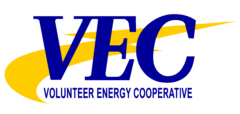Volunteer Energy Cooperative Right-of-Way Guidelines
By Brad Rhea
One of the many benefits of living in our part of the country is the abundance and variety of vegetation, but as many know, trees and power lines do not mix. Vegetation growing into uninsulated power lines can become energized and may pose a hazard to the public. Along with the public, vegetation can also cause problems for power utilities. Trees can grow into power lines or break and fall onto them. Also, vines can climb electrical poles and wrap around transformers and lines. Any of these events can cause power interruptions.
Because of this, Volunteer Energy Cooperative (VEC) manages vegetation along power line right-of-ways. The goal of vegetation management is to prevent as many of power interruptions as possible. Vegetation management includes pruning trees, cutting down dead or hazardous trees, clearing around power poles and other electrical equipment, mowing undergrowth, and making herbicide applications.
VEC maintains a 40 feet right-of-way along our overhead primary power lines, that’s 20 feet on either side of the power lines. We ask that nothing be planted inside the right-of-way area. Even if vegetation is planted on the edge of the right-of-way, plants don’t only grow up but also grow out. That means even vegetation planted outside the right-of-way can still grow into it and may need to be pruned back in order to maintain our recommended clearance.
Here are some guidelines to consider when planting near power lines:
- Trees less than 25 feet in height and spread at maturity can be planted in the “small tree zone,” which is 25-40 feet from the line.
- Trees less than 40 feet in height and spread at maturity can be planted in the “medium tree zone,” which is 40-60 feet from the line.
- Trees with over 40 feet height and spread at maturity need to be planted in the “large tree zone,” which is at least 60 feet from the line.
These guidelines are in effect to not only keep vegetation from growing into or falling onto power lines, but to also allow linemen safe access to right-of-ways.
Following these guidelines can also help speed up the restoration of power when an outage does occur. Access is critical when restoring power. Even though shrubs and hedges planted in the right- of-way areas may not be tall enough to grow into the power lines, they may be an obstacle for crews trying to perform maintenance or make repairs.
Overhead primary lines are not the only concern when it comes to vegetation management. We also have to be able to access our underground equipment. Therefore, we ask that nothing be planted within 10 feet of our underground transformers.
With a little planning and foresight, we hope the need for vegetation management along our right-of-ways can be reduced and trees and power lines can coexist. VEC also strongly encourages members who want trees inside the 40 feet right-of-way removed to contact us to discuss the possibility. For the Crossville and Jamestown service areas, contact Right-of-Way Superintendent Brad Rhea at 931-484-3527 extension 7234. For the Decatur and Cleveland service areas, contact Right-of-Way Coordinator Allen Ratledge at 423-334-1020 extension 7034.
